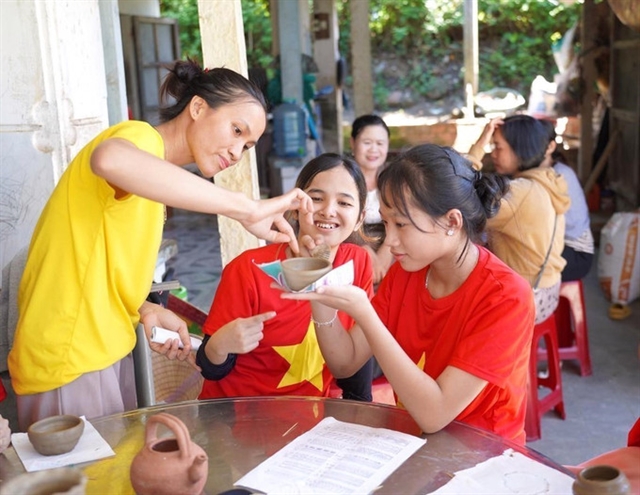 Travel
Travel
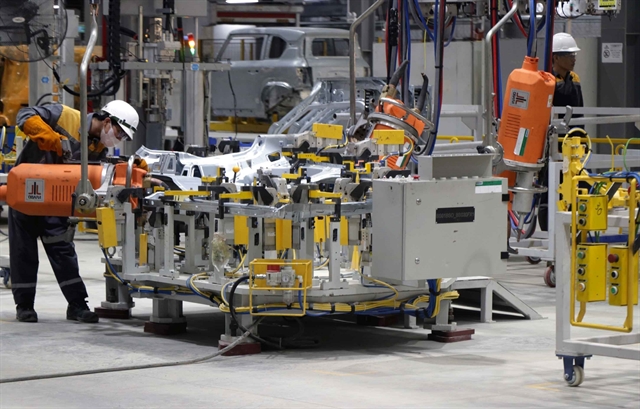
Visiting Thailand has never been boring to me, since the country is not only the kitchen of the world, but also a hub of activities and festivals.
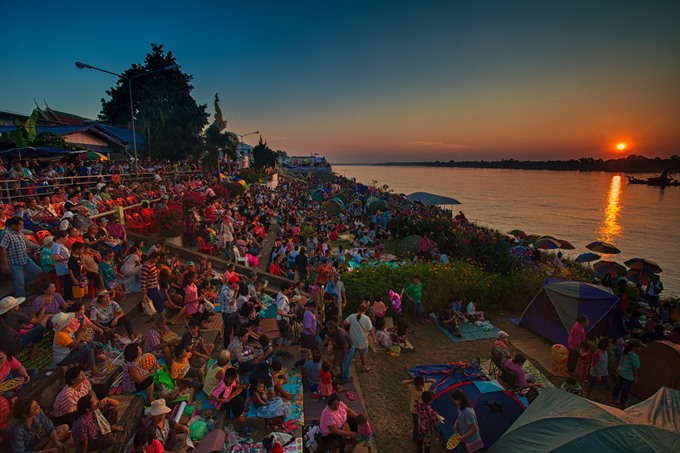 |
| People gather to admire the Naga fireballs in Nong Khai Province. Photo courtesy of TAT |
By Khiếu Thanh Hà
Visiting Thailand has never been boring to me, since the country is not only the kitchen of the world, but also a hub of activities and festivals.
Returning to the country after one year, I found a different angle that I plan to fly back even though I was still on my vacation.
Bangkok, Pattaya and Phuket are familiar destinations to many tourists, including me. This time, I travelled to the countryside in Nong Khai Province, which is more than 600km from the capital city.
Spending nearly an hour on Thai Smile Airways, I reached the long thin province that runs along the Mekong River in the Northeastern Isaan Region.
It is home to an extraordinary natural phenomenon that has lasted for centuries, which local people call the Naga Fireballs. It takes place only in the evening, one day, once a year, and often at the end of the three-month Buddhist Lent in October, a time at which Buddha is said to descend to earth from heaven. It is usually seen in Phon Phisai District.
Naga, in the Thai language, is a mythical serpent-like creature, believed by locals to live in the Mekong or its estuaries. It protects its residents. People say that the mysterious balls are made by the Naga, in order to call the Buddha to return to Earth.
The glowing balls, reddish in colour and in various sizes, are alleged to naturally burst from the bottom of the river, sprint above the water surface, and then move skyward for a couple of hundred metres before disappearing.
“I have come to watch it every year, and am always excited to wait for it, as if it was the first time. I believe many people feel like me,” said Thanawit Parnchookaew, a Vietnamese-Thai living in the province.
“Nobody knows when the fireballs start. We just prepare food and drinks in the morning, drive to the place and wait until night. Sometimes it is early, at 6pm, but sometimes it is at midnight. It can come up with one ball, or six to seven balls at the same time. It is really an incredible scene that everyone should see once in their lifetime,” Thanawit said.
The number of fireballs varies from year to year, anywhere from 10 to 1,000.
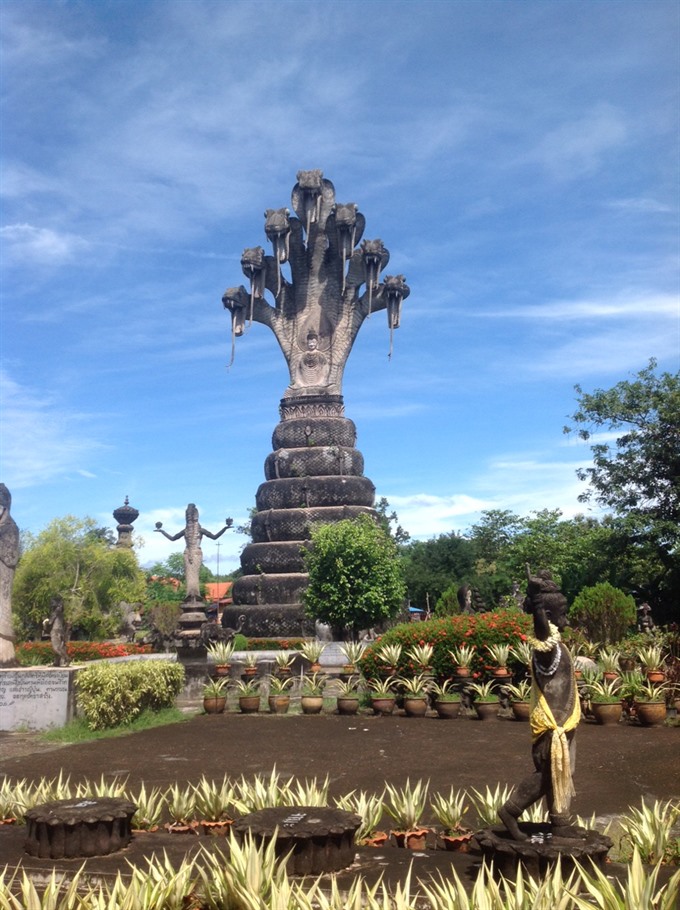 |
| Budda Park in Nong Khai Province is home to giant fantastic concrete sculptures inspired by Buddhism and Hinduism. — VNS Photo Khiếu Thanh Hà |
Nong Khai has welcome many scientists who seek to discover the answer to the phenomenon. There are some explanations, but the cause of these balls remain unproven.
And I have decided that I will be one of some half million people from throughout the world who make the journey to Nong Khai to try and decide for myself what it is. This year, the fireballs are expected to rise up on October 16.
Whether you believe or not, a journey to Nong Khai would not be wasted, Thanawit said.
Aside from all the usual delights, the Naga Fireball Festival, which surrounds the night of Mekong Fireballs, provide visitors with a chance to enjoy the local culture.
The seven-day festival, according to Seksan Sripraiwan, director of the Tourism Authority of Thailand’s Udon Thani and Nong Khai offices, also includes a bazaar, a contest of floating and illuminated boats in worship of the Naga, and long-boat races.
The area is filled with huge street parties, delicious food and drink, as well as performances of various kinds, including traditional music and dance shows.
While waiting for the fireballs, I spent time discovering the Sala Kaeo Ku, the Buddha Park, which is home to huge, strange and amazing concrete sculptures.
It was built by, and born out of the vision of Shaman Luang Pu Bunleua Surirat and his followers in the early 1980s.
There are hundreds of statues in the park, including images of Shiva, Vishnu and Buddha, as well as many other figures from Hindu and Thai culture, amongst others, telling different stories of religious life. It is the scale of the sculptures that is truly awesome, with some towering over 25m high.
Surirat passed away in 1996, leaving several statues unfinished.
The Tha Sadet Market, or Indochina Market, was my next destination.
This "must see" covered market runs alongside the Mekong River and is a favourite attraction for many visitors to the province.
Nong Khai has always been an important trading post in the Indochina region, and there is still a ferry that runs from the Tha Sadet pier, across to Tha Dua in Laos. This used to be the main route to Laos, until the opening of the Thai-Laos Friendship Bridge in 1994.
The market offers many kinds of clothing, which are mainly weaved with traditional Thai patterns.
I was ‘swimming’ among dresses, shirts, pants and scarves, which were all selling at reasonable prices, much lower than in other places, such as Bangkok or Pattaya. There was sure to be something to interest every shopper.
The market was also an ideal place to pick up souvenirs, such as wood carvings, silverware, local produce and much more.
I returned to my hotel with a small, cute ring and a wonderful skirt.
During my trip, I was told about a new attraction in the province, a U-shaped skywalk at Wat Pha Tak Suea temple in Sangkhom District of Nong Khai.
The 16m long skywalk is built overlooking a cliff, and has glass floors and walls. It welcomed its first visitors in early April.
Up to 20 tourists can walk along the skywalk at one time to see, from on high, panoramic vistas over the Mekong and across into the virgin countryside of Laos.
It is on my list to visit, when I am again back for the fireballs event.
I will also take a walk to the Friendship Bridge which, in my opinion, all Thais are proud of it.
They talk and talk a lot about the construction that spans the Mekong and connects Thailand to Laos, providing an excellent vantage point from which to take in magnificent views of the river. At the weekend, the bridge is opened up to pedestrians from both sides to stroll on and admire the views.
People will arrive from Vientiane, the capital of Laos as it is only 25km from the bridge, and be free to discover other people, cultures and attractive sites.
And what is to be named on my list: the Wat Pho Chai, the most important of Nong Khai’s temples; Phra That Bang Phuan, one of the most sacred sites in the Isaan Region; Phu Wua Wildlife Sanctuary, which contains a number of beautiful waterfalls; October’s 10-day Chinese Dragon Festival, where ceremonial dragons are paraded around streets, together with Chinese cultural events that include dance and opera shows; and November’s Loy Kratong, the festival of lights, which is held to pay respect to the goddess of the rivers and waterways. VNS
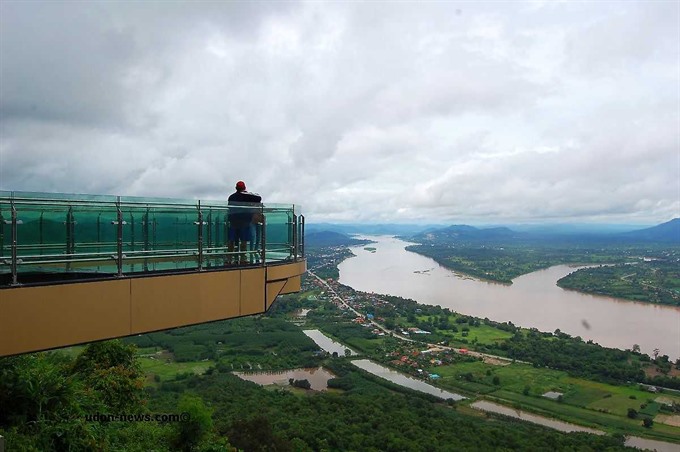 |
| The glass skywalk offers a bird’s eye view of the Mekong River, providing a beautiful backdrop to photographers. — Photo udon-news.com |